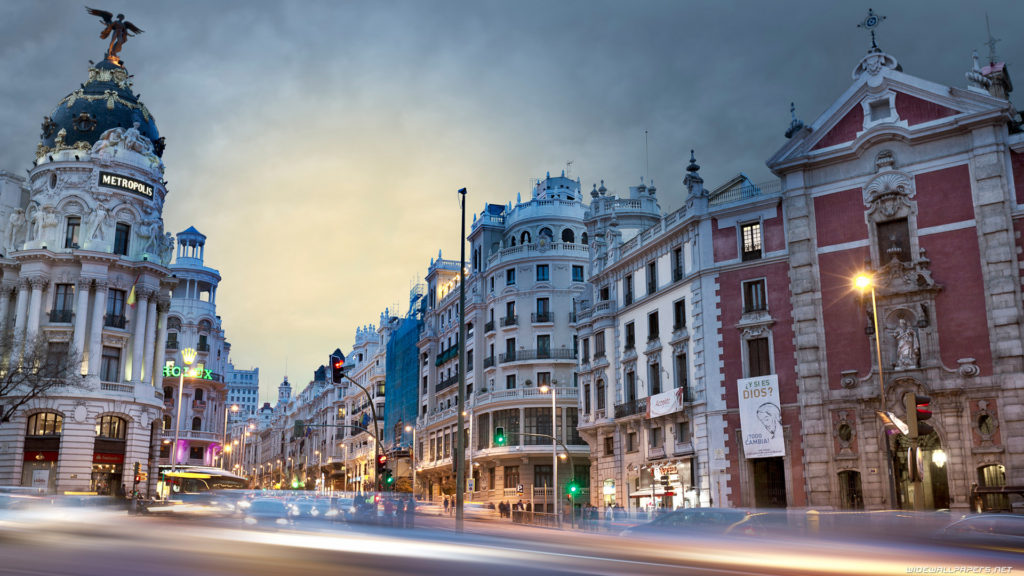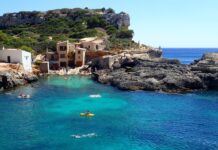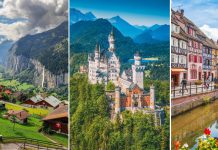
Madrid has something for everyone: a student of history, an art lover, an outdoor enthusiast, or a simple tourist. It has a number of art galleries and museums, palaces and parks. A walk down the many plazas is an enriching experience and the best means of absorbing the essence of the old city. Finally, the nightlife is among Europe’s best.
It is a good idea at the beginning of the trip to visit the main tourist office at Duque de Medinaceli and collect maps and information booklets. Once you have an idea of the location of the main spots, plan your itinerary and route, and enjoy Madrid!
Walk around the city and soak in the local flavor and culture. Puerta del Sol, or the Gateway of the Sun, is the liveliest area of Madrid and lined with shops and cafes. Admire the statue of Carlos III in the center of the square, and look at the special statue opposite it: a bronze statue of the symbol of Madrid, a bear reaching for fruit from a strawberry tree!
Next, take a walk down the Gran Via or the main traffic route. It is lined by international buildings like the Edificio Metropolis and Edifices la Estrella. The carved stone decorations and gargoyles are intriguing.
The square of Plaza Mayor has an equestrian statue of Felipe III, and is lined with elegant arcades, cafes and craft shops. Look at the facade of the Casa de la Panaderia and mark the beautiful allegorical paintings. A visit to the collectors’ market on Sunday is a must!
If you love fountains, take a trip to the Plaza de Cibeles, which has a lovely fountain with a statue of the Roman goddess Cybele. The Plaza Canovas del Castillo has a sculpted fountain of Neptune in his chariot.
The Puerta de Alcata, sculpted of granite, was earlier the gateway to the city. Visit it at night, when the floodlit monument is a breathtaking sight. For lovers of architecture, The
Monasterio de las Descalzas Reales is a rare surviving example of 16 th century architecture. Apart from paintings by Titian and Ribera, it has stunning tapestries in the Sala de Tapices.
The vast Palacio Real is an 18 th century Bourbon palace. Among its major attractions are the Porcelein room, Gasparini room, Dining room and Throne room. The walls and ceiling of the Porcelain room are covered with green and white porcelain, which is embossed with cherubs and wreaths. The Dining room too has painted ceilings and Flemish tapestries. Take a 45 minutes guided tour of the Royal Palace through the apartments and Royal Armory. The latter has one of the world’s best collections of medieval weapons.
Madrid is an art lover’s paradise. Paseo del Prado is based on Rome’s famous Piazza Navona, and has a number of museums and art galleries. The Museo del Prado and Museo Thyssen-Bornemisza house world famous collections, specially of Dutch and Flemish masters. Make sure you see the most famous Flemish painting at the Museo Thyssen-Bornemisza: “Our Lady of the Dry Tree.”
Prado Museum is one of the world’s leading art galleries. The best way to see the museum is to enter through the new reception center. The works are arranged in schools, with the oldest works on the lowest floors. There are magnificent works by the old Spanish masters from the 12 th to 19 th centuries, and major works by Velazquez and Goya. A number of Flemish and Italian masters are also represented. The Velazquez collection includes famous paintings like “The Triumph of Bacchus” and “Las Meninas” by Velazquez, Spain’s leading court painter. This collection, along with 17 th century Spanish works, is on the first floor. Make sure not to miss El Greco’s famous “The Adoration of the Shepherds” and “Martyrdom of St. Philip” by Jose de Ribera.
The Goya collection and 18 th century European works are housed on the second floor. Major attractions by Goya are “The Clothed Maya” and “The Naked Maya”, “The 3 rd of May”, and “The Black Paintings.” The latter depict the horrors of war. Other famous works are “The Three Graces” by the Flemish master Reubens and “The Garden of Delights” by El Bosco. Among the Flemish and Danish masterpieces are “The Deposition” by Rogier Van der Weyden”, “Artemesia” by Rembrandt and “The Adoration of the Magi” by Reubens. The Italian masters represented here are Botticelli, Raphael, Tintoretto and Titian. You would certainly need more than one visit to appreciate all the exhibits!
If you enjoy 20 th century art, head to the Reina Centro de Arte Reina Sofia (Sofia Museum) and admire Picasso’s famous “Guernica.” If time permits, you could also visit Museo Sarolla, Museo Arqueologico (National Archaelogical Museum), Museo de America and the Naval Museum.
After a surfeit of art at the museums, it might be a good idea to enjoy a picnic! The palace gardens, specially the Campo del Moro, provide the perfect setting. However, they are closed to the public during royal visits. Another popular picnic spot is the Botanic Gardens, near the Prado. The Parks are free, and especially colorful on Sundays, so take a stroll and soak in the atmosphere. The Parque del Retiro (Retiro Park) has a rowing lake, theater, fountains and statues, while the Casa de Campo is an even bigger park. Finally, enjoy street shows by gypsies at the flea market Rastro on Sundays!
A visit to Madrid should include a glimpse of its famous sport: bullfighting. Even if it is not to your taste, simply visit The Plaza de Toros de Las Ventas, which is Madrid’s magnificent bull ring. Moreover, you might find the adjoining Museo Taurino interesting, with its bull fighting memorabilia.
If you have an extra day, take a short excursion to the monastery-palace complex of San Lorenzo del Escorial (48 km away) and the nearby Valle de Los Caidos.
It certainly takes more than one visit to enjoy all the sights of Madrid, but if you can cover all or at least most of the attractions mentioned above, it will be a memorable trip!











